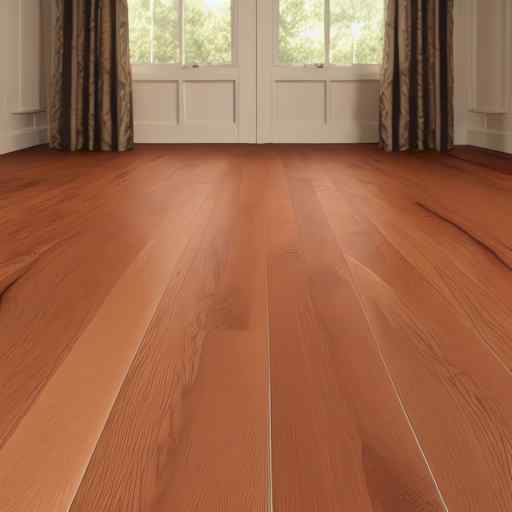Distinguishing Red Oak From White Oak Flooring: A Detailed Guide

Introduction
The Ascendancy of Oak in Flooring Choices
Oak has long been esteemed as a preferred material for flooring due to its remarkable durability, captivating natural aesthetic, and timeless appeal. It has carved out an indomitable place for itself in the realm of interior design, with both homeowners and professional designers lauding its versatility. Whether employed within the context of a modern minimalist living space or a traditional rustic abode, oak flooring imparts an innate warmth and sophistication that few other materials can rival.
The allure of oak is not merely confined to its pleasing visual characteristics. Its inherent hardness makes it resistant to wear and tear, rendering it an ideal choice for areas subject to high foot traffic.
The density of oak further contributes to its sound absorption capabilities - a trait particularly beneficial in multi-story residences or commercial spaces. With proper care and maintenance, oak floors can provide not just years but generations of service while retaining their intrinsic charm.
The Nuances Between Red Oak and White Oak Flooring
While "oak" may be used as a broad term when discussing hardwood flooring options, it is worth noting that there are primarily two types available: red oak and white oak. Each boasts distinct characteristics beyond merely their coloration that contribute to their utility in different applications. Discerning between these two varieties holds significant import not just from an aesthetic perspective but also considering factors like durability, cost considerations, stain retention capacity among others.
Red oak tends toward warmer tones with a more pronounced grain pattern while white oak offers cooler hues and tighter grain patterns - subtle differences which could dramatically influence the ambiance of a room depending on the choice made. The hardness level varies between the two with white being marginally harder than red - possibly influencing decision based on expected foot traffic levels.
Additionally understanding how each type absorbs stains could potentially prevent undesirable discolorations post installation. In essence, grasping these variances between red oak and white oak is instrumental not only in making informed decisions regarding your flooring choice but also ensuring you secure optimal value for your investment while achieving your desired aesthetic outcomes.
The Quintessence of Oak Flooring
Universally hailed for its exceptional durability and aesthetic appeal, oak flooring represents an amalgamation of brawn and beauty. Known for its dense, tight grain and robust structure, oak is resistant to dents and scratches, making it an excellent choice for high-traffic areas in homes or commercial spaces.
Furthermore, the natural variation in color from board to board adds visual depth and a unique character to each installation. Beyond its inherent strength, oak flooring exhibits a versatility that lends itself well to various finishes.
Its broad spectrum of shades ranges from light beige through rich brown hues. Whether homeowners prefer a dark, elegant look or a light, contemporary style, the flexibility of oak accommodates diverse aesthetic preferences with finesse.
Time-Honored Timber: Historical Uses and Popularity
Sinewy yet sophisticated -- the use of oak as a flooring choice stretches back centuries due to its unparalleled combination of strength and beauty. Historically used in shipbuilding during the age of exploration due to its resistance against rotting when wet -- a testimony to its natural durability - oak was soon incorporated into architectural designs by discerning builders who recognized its potential beyond seafaring. Fast forward to the early 20th century; with the advent of tongue-and-groove technology paving way for mass production, wood flooring became more accessible.
Oak quickly gained popularity as it complemented various architectural styles ranging from Victorian design sensibilities right through to modernist minimalism. Today, the legacy continues as oak remains an enduring favorite among discerning homeowners who seek out timeless elegance coupled with lasting functionality.
Distinguishing Features of Red Oak Flooring
A Colorful Canvas: The Reddish-Pink Hue of Red Oak
Red oak flooring, true to its name, presents a warm, rich color palette that often leans towards reddish pink. This subtle but distinct hue comes from the tree's interior heartwood. The color spectrum can range from a creamy pink in lighter pieces to a deep, ruddy brown in darker selections.
Each board holds an individualistic mix of these tones, offering a symphony of warmth and richness that makes each floor truly unique. In rooms with ample natural light, this reddish-pink hue can create an inviting ambiance by accentuating the flooring's inherent warmth.
It also provides an excellent contrast to walls or furniture in cool tones such as blues or greens. In addition, the red oak's distinctive coloration allows for versatile design aesthetics -- from rustic country-style homes to modern minimalist interiors.
Underlying Patterns: The Open and Wavy Grain of Red Oak
The grain pattern of red oak is another distinguishing characteristic that sets it apart from other hardwood options. It showcases open pores arranged in sweeping lines and waves across each plank's surface -- an attribute contributing to its unique aesthetic appeal.
These distinctive patterns bring life and movement to your floors as they catch light from different angles throughout the day. Furthermore, due to these open grain patterns, stains are absorbed more deeply into red oak than other hardwoods such as white oak -- allowing for richer and darker stain applications if desired.
Feels Right: Coarse Yet Smooth Texture of Red Oak Flooring
Despite having coarse grain patterns visually, one would be surprised by the smooth texture underfoot when walking on red oak floors. This perceptible contradiction between sight and touch creates a tactile interest that only adds to the charm of red oak flooring. Over time with wear and usage, this smooth texture is maintained thanks to the hardness level offered by red oak - making it not only visually pleasing but also practical for homeowners desiring durability without compromising comfort.
Measuring Up: Understanding Janka Hardness Rating
When discussing hardwood flooring options' durability aspects like resistance to dents or scratches, professionals often refer to the Janka Hardness test results. For red oak flooring specifically, it has a rating around 1290 lbf (pound-force), which is considered medium-hard among commonly used wood species for flooring. This mid-range hardness implies optimal balance between resisting wear while simultaneously permitting easier installation compared with harder wood varieties - since nails can be driven into it relatively easily without pre-drilling holes.
Timeless Beauty: Longevity And Resistance To Wear Of Red Oak Flooring
Considering its decent hardness rating along with inherent structural properties like open-grain structure allowing deeper stain penetration--thus providing additional protection--red oak offers impressive resistance against wear over time. Indeed, properly cared-for red oak floors have been known to last several decades--even centuries--in some historical buildings! In our fast-paced world where trends come and go at lightning speed; opting for durable materials like these that retain their beauty over time is indeed choosing timeless elegance.
Identifying Characteristics of White Oak Flooring
A Closer Look: Color and Grain Pattern
White oak flooring is a beautiful addition to any home, offering an array of hues from light beige to medium brown. This color range provides a more neutral palette compared to red oak's more vibrant undertones, which can be leveraged to create an elegant, serene ambiance in your living space. Apart from its coloration, the grain pattern of white oak flooring is another distinctive feature that sets it apart.
Exuding a subtle sophistication, white oak displays tighter and less porous grain patterns than its red counterpart. These closed-grain patterns offer a smoother visual texture that contributes to its overall refined aesthetic appeal.
Texture: A Tactile Experience
Despite having a less visible grain pattern, the texture of white oak can be slightly rougher than that of red oak. While this does not compromise the comfort or walking experience on these floors, it does add another tactile dimension--giving the flooring its signature rustic charm. While both varieties are smooth underfoot, you may notice a slightly increased resistance when running your hands over white oak flooring--a testament to its unique character and natural charm.
Hardness and Durability: Standing the Test of Time
White oak's allure extends beyond aesthetics--it is also heralded for its superior hardness levels. Rated higher on the Janka Hardness Scale than red oak--1360 vs 1290 respectively--white oak offers greater resistance against dents and scratches making it an ideal choice for high traffic areas in homes or commercial spaces. In addition to this enhanced durability, white oak boasts an increased longevity owing largely to its closed-pore structure.
The lesser permeability not only contributes aesthetically but also functionally--it resists rot and decay better than open-grained woods like red oaks. Thus with proper care, white oak floors can retain their beauty for generations.
Painting the Picture: Aesthetic Differences
Red oak and white oak flooring, though from the same family, present distinct aesthetic dimensions. The most conspicuous difference is their coloration.
Red oak offers a vibrant palette of pinkish to reddish hues that breathe life and warmth into any space. Its open, wavy grain pattern forms an engaging visual texture, making it an enchanting option for those who prefer a dynamic yet traditional ambiance.
On the other hand, White oak sets a different mood altogether with its light to medium brown tones. It leans towards cooler shades compared to its red counterpart -- a perfect choice for creating serene or contemporary decors.
The grain pattern in white oak flooring is tighter and less porous than red oak's. This subtle pattern often results in a cleaner and more consistent look that complements minimalist interior designs exquisitely.
Battle of the Oaks: Durability Showdown
The difference between red and white oaks doesn't stop at aesthetics - their intrinsic properties also diverge significantly when it comes to durability. Red oak flooring, while notably durable with a Janka hardness rating of 1,290 lbf (pound-force), showcases excellent resistance to wear over time. Its open grain structure makes it slightly susceptible to damage from moisture or pests but generally serves as robust flooring material.
White oak outshines its red cousin in terms of resilience due largely to its closed-grain structure which renders it highly resistant to rot and water damage - earning it a superior Janka hardness rating of 1,360 lbf. The denser grain translates into an impressive longevity that can withstand generations' wear and tear without losing its charm - making white oak flooring not just an investment in your home's aesthetic appeal but also its structural durability.
A Penny for Your Oak: Cost Implications
Last but certainly not least on our comparison list are cost considerations between red and white oaks. As with most construction materials, various factors influence the price point such as quality grade, location source, transportation costs among others; however, we can derive some general observations when comparing these two types of wood.
In general terms, red oak tends to be moderately priced; hence more budget-friendly than White Oak due primarily because it is more plentiful across North America compared to White Oak trees which are fewer in number hence rarer thus driving up their pricing marginally higher than Red Oak's. However considering both their unique attributes & long-term durability especially with White Oak's superior resistance quality one could argue paying extra penny might be well worth over longer duration usage.
Effects Of Staining On Red And White Oak Floors
A Transformation in Aesthetic: How Staining Can Alter Appearance
Staining is a potent tool at a homeowner's disposal to drastically transform the character of their oak flooring. It can deepen the wood's natural hue, introduce an entirely new shade, or highlight the grain's distinctive patterns. Red oak, with its larger pores and more pronounced grain, tends to absorb stain quite assertively--an attribute that can add dramatic depth and complexity to its already vibrant undertones.
The resultant floor can range from a warm amber if a light stain is applied, up to rich mahogany shades for darker stains. White oak flooring responds differently.
Its tighter grain and less porous nature yield a subtly different staining profile. The absorption of stain tends to be more uniform across the planks.
This characteristic often produces a smoother finish, allowing for greater control over the final color consistency throughout your space. Whether you aim for an elegant cherry-blossom pink or a sophisticated gunstock brown, white oak provides an impressive adaptability in aesthetic transformation.
Contrasting Absorption Capabilities: Differences in Stain Absorption Between Red & White Oaks
Understanding how each type of oak absorbs stain adds another layer of insight into how one might choose between red and white oak flooring. As mentioned earlier, red oak has open pores making it absorb stains thoroughly and deeply--a trait which often creates exciting variations and intensifies grain contrast upon staining. In stark contrast stands white oak with its closed-pore structure that tends to absorb fewer pigments during staining resulting in lighter shades compared to red oak when same stain is used on both types of oaks.
As such, while staining may dramatically alter red oak's appearance; it retains white oaks' subdued elegance by gently highlighting--rather than redefining--its existing hues. So whether you desire bold chromatic shifts or subtle enhancements onto your floors' existing charm - understanding these differences allows you make informed choices about staining your unique red or white oak flooring.
Application And Use Cases For Both Types Of Oaks
Unraveling the Potential of Oaks in Various Scenarios
Red oak, with its distinctive grain pattern and warm hue, is a great fit for traditional or rustic decor. Its open grains absorb stain well, granting a depth of color that adds richness to any room.
Red oak's resilience against wear and tear also makes it suitable for high-traffic areas such as living rooms and corridors. White oak, on the other hand, is often favored in contemporary settings due to its subtle grain pattern and lighter coloration.
The closed pores of white oak not only offer higher resistance to rot but also create a smoother finish when painted or stained. The durability of white oak makes it an excellent choice for flooring in areas exposed to moisture like kitchens or bathrooms.
Suitability Beyond Surface Aesthetics
Choosing the Oak that Fits Your Needs Best
When considering red vs white oak flooring, one should take into account not only their visual appeal but also practical factors like hardness, durability, and cost. Homeowners who appreciate vibrant grains may favor red oak flooring while those seeking subtler aesthetics might choose white oaks.
In terms of hardness, while both types are durable choices for residential flooring, white oak's greater hardness can be beneficial in commercial spaces with heavy foot traffic. As for cost considerations, generally speaking red oaks tend to be somewhat less expensive than their white counterparts; however prices fluctuate based on region and availability.
Concluding Thoughts
The Symphony of Oaks: A Flourishing Finale
In essence each type of Oak - red or white - beholds its own unique charm and practical strengths making them both commendable choices as per individual requirements. The quest to distinguish between these two majestic types of woods illuminates the beauty underlining our everyday lives encouraging us to observe closely the world around us thus enhancing our appreciation for nature's grand opus in our very homes. Whether you're drawn towards the hearty character of red oaks or lean more towards the understated elegance offered by white oaks remember this - your choice will serve as an enduring foundation echoing your personal style creating an abode that truly resonates with your personality.



